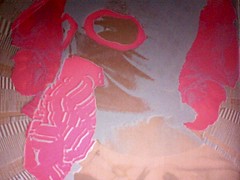

Alex Valentine compiled a lovely and colorful Yearbook for the South Philadelphia Athenaeum— available for Ten Dollars a piece— and asked me to write an introduction, a frontispiece, which follows…
The South Philadelphia Athenaeum began and thrived in an atmosphere of total implausibility. When we first found the raw space, it was nothing more than a black hole with drop ceiling. A void hidden from all municipal and physical law. Where does all the water, electricity, and gas come from? Why do we have to carry our rent, in cash, to burly Italians in smoke-filled offices? Who keeps lighting neighborhood cars on fire? The surrounding area wasn’t dangerous, only deranged and vigilante; still infected with a Frank Rizzo-era sociopathology. But it felt somewhat liberating. Pliant.
History has taught us that American culture-making is often best in the wary intersection of clever kids and a criminal underground— in this case, with us linking up with South Philadelphia soft crime.
Cities are usually under the impression that they need large, corny, multimillion-dollar initiatives to bring culture to the polis. This is exactly wrong. It grows as naturally as wildflowers. They only need to get out of the way, and let things thrive, laissez-faire. This was all we really needed: an indoor city block that could be repeatedly transformed, in accordance with our desires and delusions-of-the-week.
Truthfully, I never really thought of the Athenaeum as an artspace or a venue. This was always secondary to me, only two of the many aspects of young American culture-making, but “culture” in the way Clifford Geertz speaks of Javanese culture. A mode of life. A totalizing web of meaning. The Athenaeum was large enough, and disconnected enough, that you often felt you were remaking culture and life from the bottom-up. Like many such spaces, the Athenaeum was more like a Sim-City experiment in the moral order of Man, with its own share of mistakes and successes, rather than anything with one coherent purpose. You woke up every afternoon with the undeniable impression of living in a self-constructed universe. Afterall, we were the ones who fixed the elevators and telephone wires. We conducted the scientific experiments. We were on the board of the Olympics. We were the tenured professors. We took in orphans and stray internationals. We set the human calendar, and we decided the dates of Halloween and the meaning of “morning.” We were on television. We were responsible for all errors and false steps. We were the musicians and actors and belletrists, and perhaps even, in our own minds, famous for it.
But for reasons still alien to me, a whole chorus of forces objects to this way of thinking. Codes and zoning, cynics and resentment, city government, shady and upright neighbors, doubters, local businesses, and most decent, everyday working people. they all stand sternly contrary to our idea of a pliant universe. It’s really unfortunate.
Our unstated plan was to push this pliancy until, in the words of F.A.S. Schiller, “we were decidedly rebuked,” which in the end, we were. We could never see any definitive reason why halfpipes, bedding, and particle accelerators couldn’t fall under a single roof, or why we couldn’t live in giant volcanoes or travel through time. If one of us, by some lazy coincidence, came across several boxes of Mummers costumes, hundreds of pillows, or thousands of sodas, we always had ample counterspace for experimentation. Everything was merely prop or stock for our brand of culture-making; which was, like all culture, just a very fervid and memorable form of freeplay, of excitation. We were making Philadelphia more exciting for its visitors and citizens, remaking it into a city for homo ludens, Man the Player. A city of yes-saying, of waking up with crowded noise shows outside of your bedroom, of swinging from harnesses and taking over city fountains, of cardboard hypercubes, and of gambits and accepted risk.
Surrounded by weird props, mysterious wires and plumbing, immersive chaos, the tingle of potential, carbon monoxide scares, pathetic stopgaps, and dear friends, I could draw comparisons to the Russian Mir spacestation, or a doomed Jules Vernean space colonies, or maybe even to an elementary-school coup. This was the feeling of the place. But I can’t speak for everyone. And I can’t say what it was about the South Philadelphia Athenaeum that kept its residents so harmonious and lovey-dubby despite the dark, the cold, and the disagreement. Lesser people probably would’ve choked on the dust and hideous colors.
The other week, while purchasing a utility knife from Home Depot, I walked under a gas heater and memories from the Athenaeum seized me; memories of emerging from my room, deep in the night, with all the lights on and the heater running. I remembered stopping and surveying the warehouse, cluttered with terminally unfinished projects, bottles and cans. When the heater cut off, I could hear the whole Athenaeum snoring together in the winter silence. I remember feeling, for once, at home.
